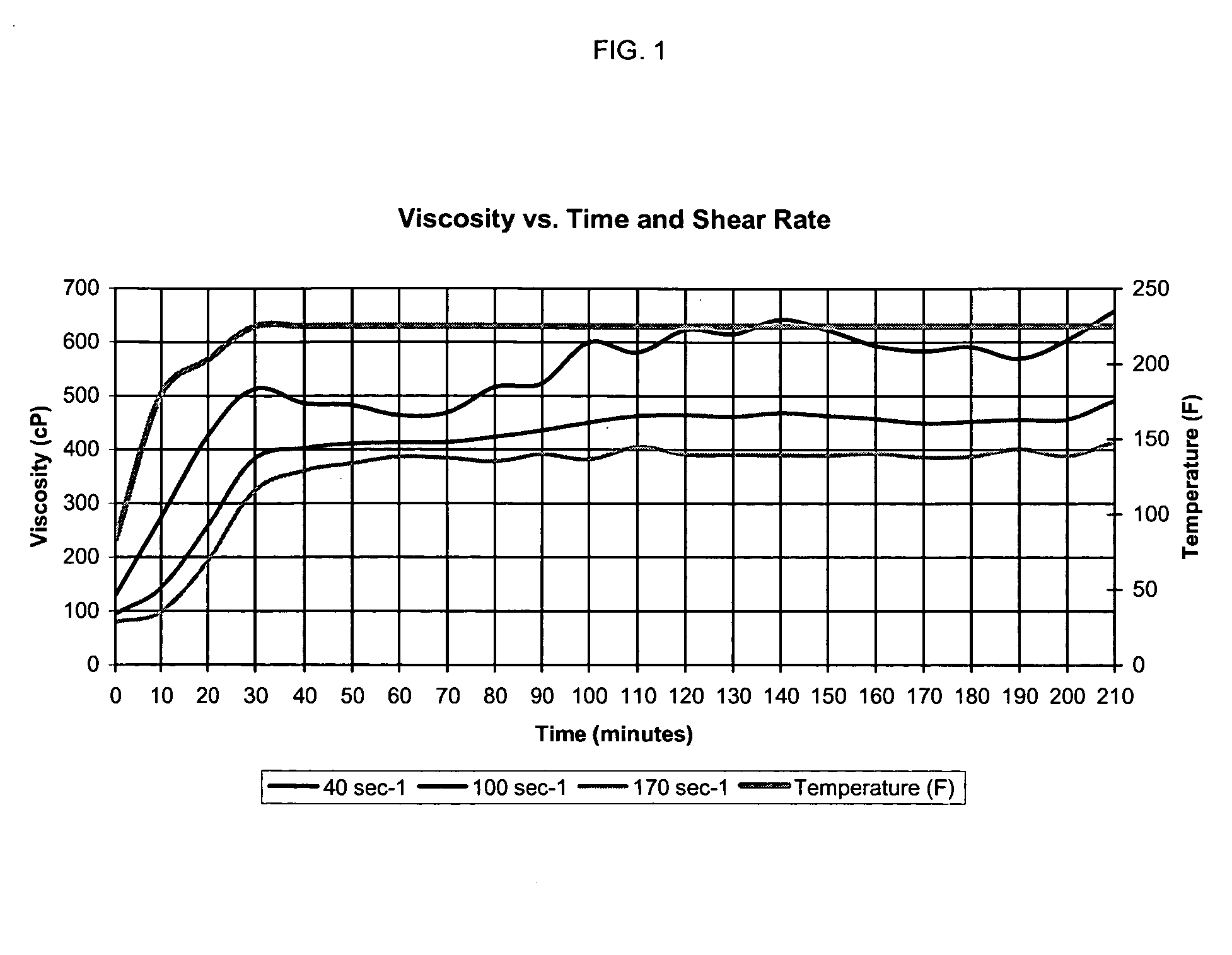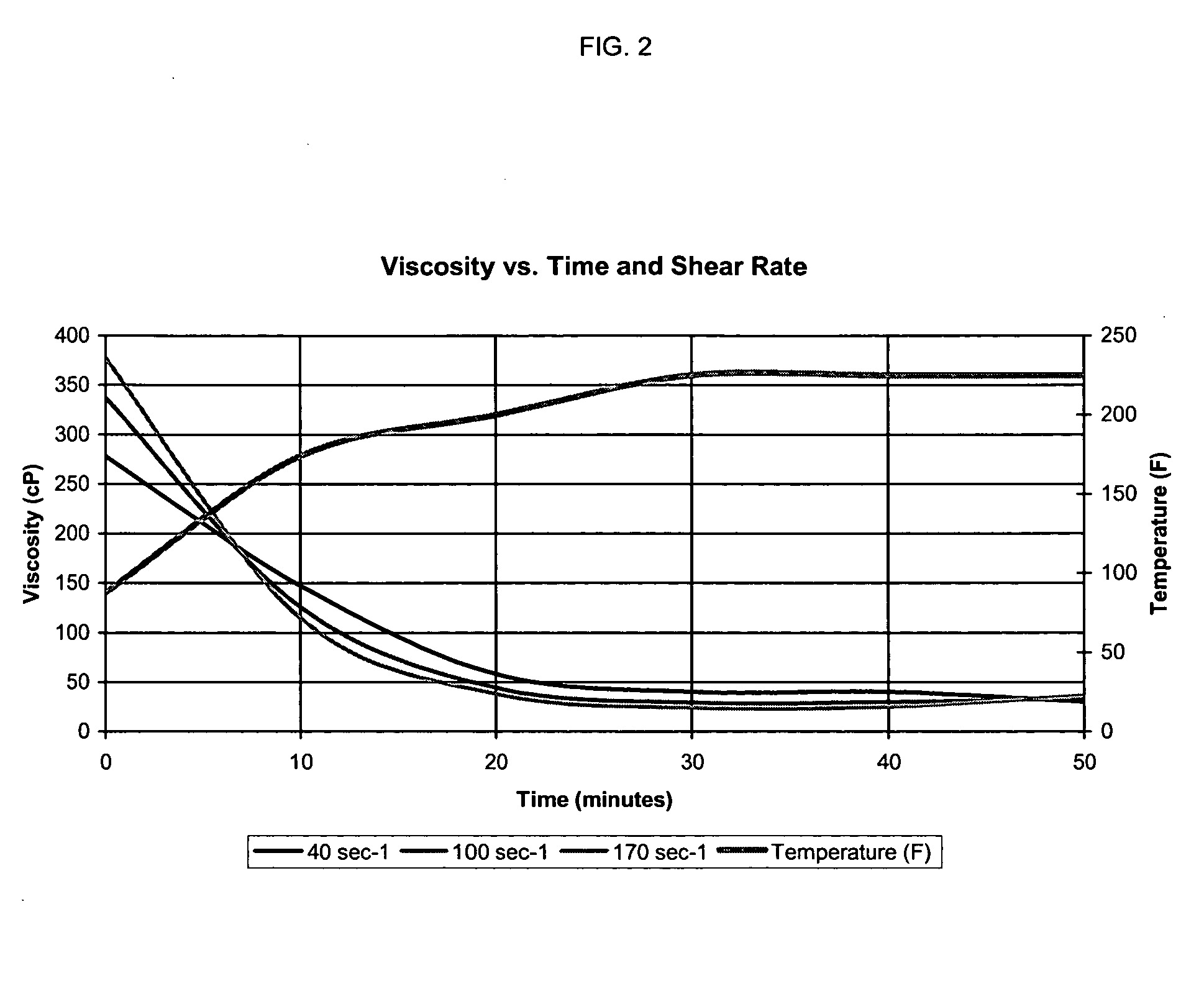Well Treatment Compositions Containing Nitrate Brines and Method of Using Same
- Summary
- Abstract
- Description
- Claims
- Application Information
AI Technical Summary
Benefits of technology
Problems solved by technology
Method used
Image
Examples
example 1
[0042]A solution was prepared by mixing 0.908 bbl of 12.5 ppg NaBr and 72.7 ppb of 99.9% sodium nitrate. The sodium nitrate completely dissolved and the solution was measure to have a density of 13.12 ppg at 76° F. The crystallization temperature of the fluid was measured to be 60° F.
example 2
[0043]To the solution in Example 1, 40 Ib / Mgal (1.68 ppb) of guar gum was added using an overhead stirrer. The solution reached maximum viscosity at 511 l / sec of 55 cp. in 15 minutes. The fluid without the guar gum had a viscosity of 3.6 cp. at 511 l / sec. The pH of the fluid was raised to 11.2 with 25% by weight NaOH and 0.15 ppb of sodium tetraborodecahydrate was added to crosslink the guar gum. The fluid was then heated to 180° F. and the rheologies measured on an OFI Model 900 viscometer at 180° F. The viscosities at shear rates of 1022, 511, 340, 170, 10, 5 l / sec is 85, 120, 169, 278, 1,100 and 1,420 cp., respectively, indicating that the fluid was crosslinked.
example 4
[0045]A brine slurry was prepared containing 40 ppg of GW-3LE guar in 13.1 ppg sodium bromide / sodium nitrate and mixed for 30 minutes using an overhead stirrer. To the fluid was then added, 4.5 gallons per thousand gallons of BF-9L, 0.10 gallons per thousand gallons of BF-10L. 3.0 gallons per thousand gallons of XLW-56 and 1.0 gallons of a borate crosslinking agent, commercially available from BJ Services Company as XLW-32 was also added along with 8.0 pounds per thousand gallons of sodium thiosulfate oxygen scavenger and 0.50 pounds per thousand gallons of a peroxide delayed release oxidative breaker, commercially available as GBW-24 from BJ Services Company. Thereafter, 65 ml sample of the fluid was placed into a Fann 50 viscometer cup having a bob (BX5) and rotor (R1) cup assembly fluid viscosity calculated as set forth in Example 3 above. The results are shown in Table II. The initial viscosity was 87 cP at 76° F.
TABLE IITimeTemperatureK′40 1 / sec100 1 / sec170 1 / secMinutes° F.n′lb...
PUM
| Property | Measurement | Unit |
|---|---|---|
| Temperature | aaaaa | aaaaa |
| Temperature | aaaaa | aaaaa |
| Temperature | aaaaa | aaaaa |
Abstract
Description
Claims
Application Information
 Login to View More
Login to View More - R&D
- Intellectual Property
- Life Sciences
- Materials
- Tech Scout
- Unparalleled Data Quality
- Higher Quality Content
- 60% Fewer Hallucinations
Browse by: Latest US Patents, China's latest patents, Technical Efficacy Thesaurus, Application Domain, Technology Topic, Popular Technical Reports.
© 2025 PatSnap. All rights reserved.Legal|Privacy policy|Modern Slavery Act Transparency Statement|Sitemap|About US| Contact US: help@patsnap.com


